Pathophysiology of Systemic Lupus Erythematosus (SLE)
VerifiedAdded on 2023/01/10
|15
|4172
|55
AI Summary
This assignment discusses the pathophysiology of Systemic Lupus Erythematosus (SLE), including its effects on different body systems. It also explores the history of the disease and the role of nursing staff in providing care and treatment.
Contribute Materials
Your contribution can guide someone’s learning journey. Share your
documents today.

Running head: PATHOPHYSIOLOGY
PATHOPHYSIOLOGY
Name of the student:
Name of the university:
Author note:
PATHOPHYSIOLOGY
Name of the student:
Name of the university:
Author note:
Secure Best Marks with AI Grader
Need help grading? Try our AI Grader for instant feedback on your assignments.
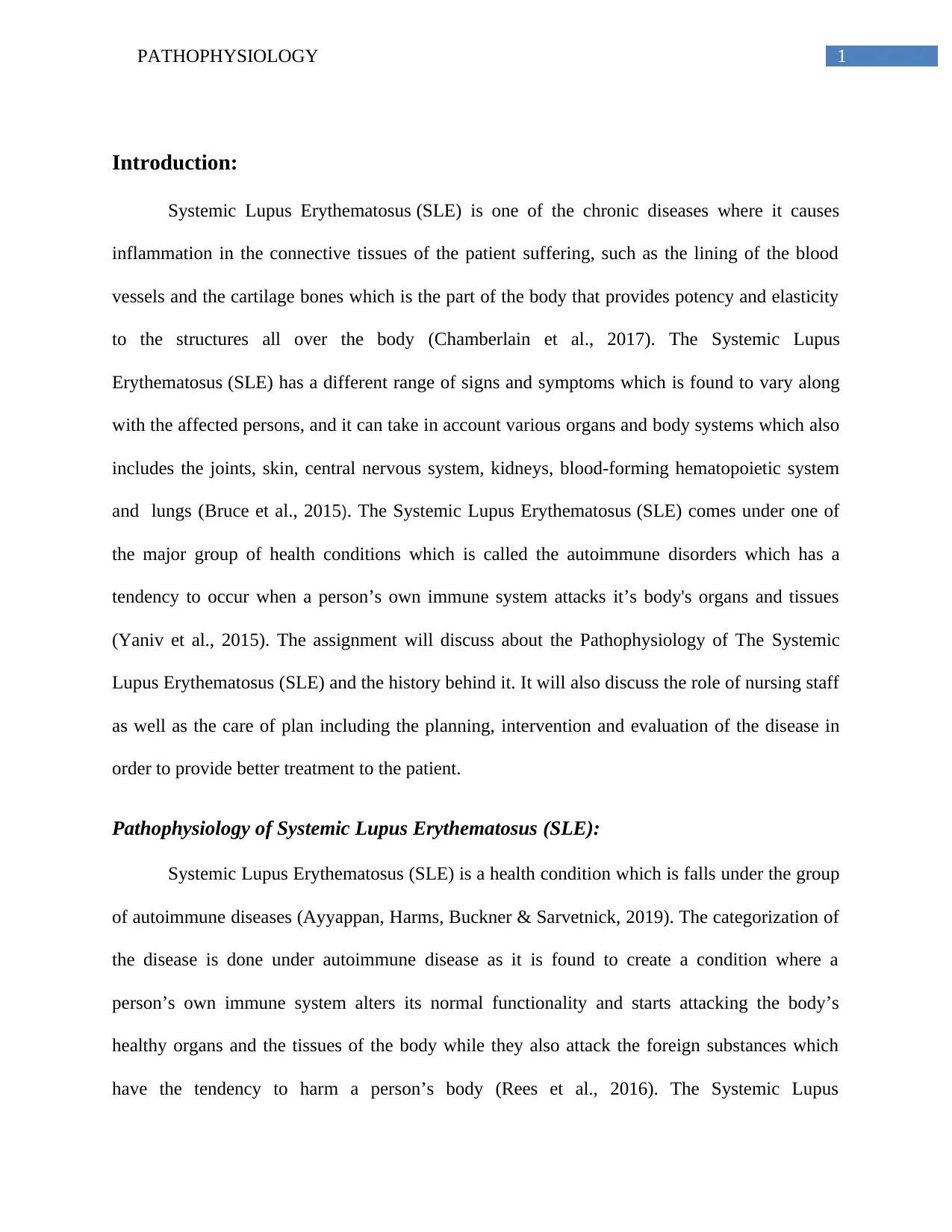
1PATHOPHYSIOLOGY
Introduction:
Systemic Lupus Erythematosus (SLE) is one of the chronic diseases where it causes
inflammation in the connective tissues of the patient suffering, such as the lining of the blood
vessels and the cartilage bones which is the part of the body that provides potency and elasticity
to the structures all over the body (Chamberlain et al., 2017). The Systemic Lupus
Erythematosus (SLE) has a different range of signs and symptoms which is found to vary along
with the affected persons, and it can take in account various organs and body systems which also
includes the joints, skin, central nervous system, kidneys, blood-forming hematopoietic system
and lungs (Bruce et al., 2015). The Systemic Lupus Erythematosus (SLE) comes under one of
the major group of health conditions which is called the autoimmune disorders which has a
tendency to occur when a person’s own immune system attacks it’s body's organs and tissues
(Yaniv et al., 2015). The assignment will discuss about the Pathophysiology of The Systemic
Lupus Erythematosus (SLE) and the history behind it. It will also discuss the role of nursing staff
as well as the care of plan including the planning, intervention and evaluation of the disease in
order to provide better treatment to the patient.
Pathophysiology of Systemic Lupus Erythematosus (SLE):
Systemic Lupus Erythematosus (SLE) is a health condition which is falls under the group
of autoimmune diseases (Ayyappan, Harms, Buckner & Sarvetnick, 2019). The categorization of
the disease is done under autoimmune disease as it is found to create a condition where a
person’s own immune system alters its normal functionality and starts attacking the body’s
healthy organs and the tissues of the body while they also attack the foreign substances which
have the tendency to harm a person’s body (Rees et al., 2016). The Systemic Lupus
Introduction:
Systemic Lupus Erythematosus (SLE) is one of the chronic diseases where it causes
inflammation in the connective tissues of the patient suffering, such as the lining of the blood
vessels and the cartilage bones which is the part of the body that provides potency and elasticity
to the structures all over the body (Chamberlain et al., 2017). The Systemic Lupus
Erythematosus (SLE) has a different range of signs and symptoms which is found to vary along
with the affected persons, and it can take in account various organs and body systems which also
includes the joints, skin, central nervous system, kidneys, blood-forming hematopoietic system
and lungs (Bruce et al., 2015). The Systemic Lupus Erythematosus (SLE) comes under one of
the major group of health conditions which is called the autoimmune disorders which has a
tendency to occur when a person’s own immune system attacks it’s body's organs and tissues
(Yaniv et al., 2015). The assignment will discuss about the Pathophysiology of The Systemic
Lupus Erythematosus (SLE) and the history behind it. It will also discuss the role of nursing staff
as well as the care of plan including the planning, intervention and evaluation of the disease in
order to provide better treatment to the patient.
Pathophysiology of Systemic Lupus Erythematosus (SLE):
Systemic Lupus Erythematosus (SLE) is a health condition which is falls under the group
of autoimmune diseases (Ayyappan, Harms, Buckner & Sarvetnick, 2019). The categorization of
the disease is done under autoimmune disease as it is found to create a condition where a
person’s own immune system alters its normal functionality and starts attacking the body’s
healthy organs and the tissues of the body while they also attack the foreign substances which
have the tendency to harm a person’s body (Rees et al., 2016). The Systemic Lupus
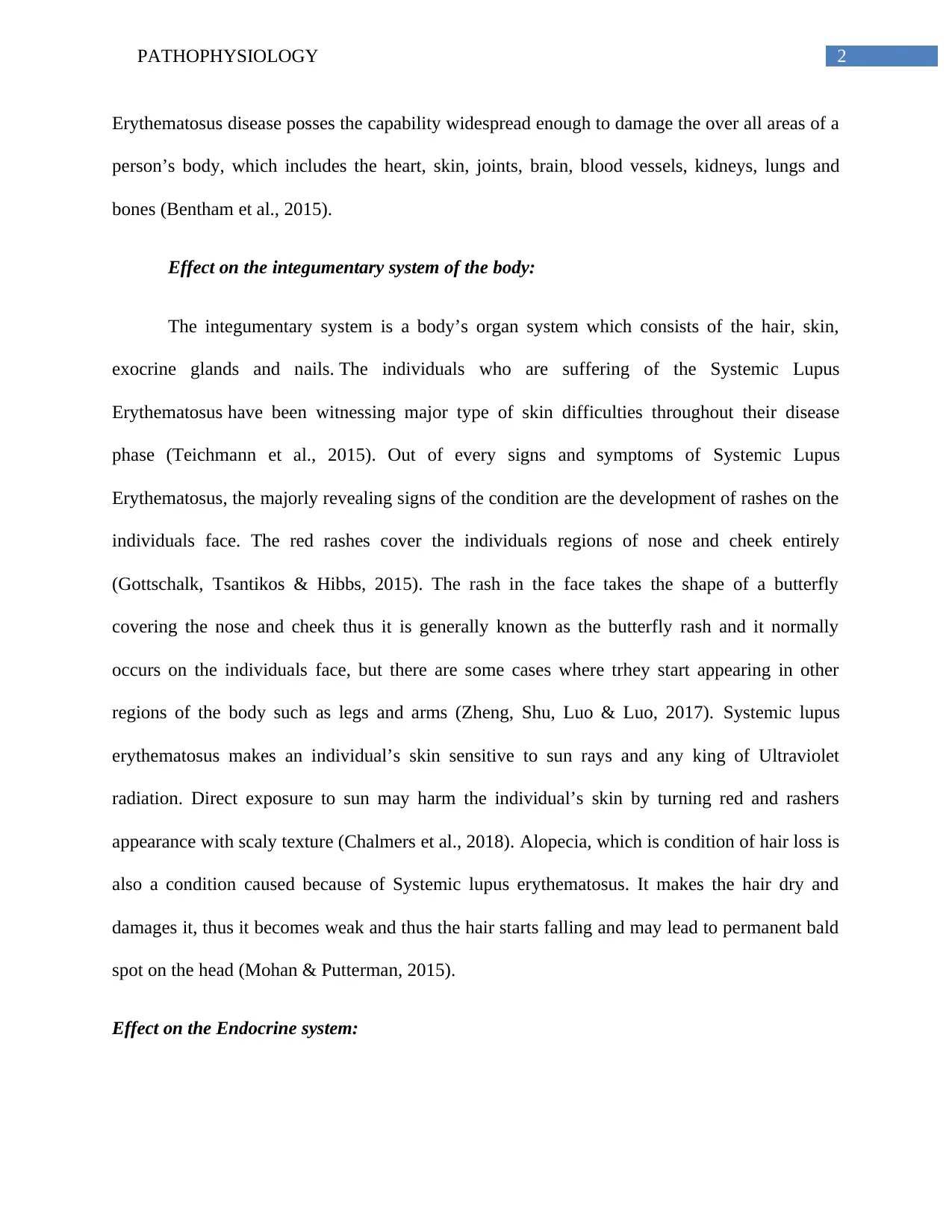
2PATHOPHYSIOLOGY
Erythematosus disease posses the capability widespread enough to damage the over all areas of a
person’s body, which includes the heart, skin, joints, brain, blood vessels, kidneys, lungs and
bones (Bentham et al., 2015).
Effect on the integumentary system of the body:
The integumentary system is a body’s organ system which consists of the hair, skin,
exocrine glands and nails. The individuals who are suffering of the Systemic Lupus
Erythematosus have been witnessing major type of skin difficulties throughout their disease
phase (Teichmann et al., 2015). Out of every signs and symptoms of Systemic Lupus
Erythematosus, the majorly revealing signs of the condition are the development of rashes on the
individuals face. The red rashes cover the individuals regions of nose and cheek entirely
(Gottschalk, Tsantikos & Hibbs, 2015). The rash in the face takes the shape of a butterfly
covering the nose and cheek thus it is generally known as the butterfly rash and it normally
occurs on the individuals face, but there are some cases where trhey start appearing in other
regions of the body such as legs and arms (Zheng, Shu, Luo & Luo, 2017). Systemic lupus
erythematosus makes an individual’s skin sensitive to sun rays and any king of Ultraviolet
radiation. Direct exposure to sun may harm the individual’s skin by turning red and rashers
appearance with scaly texture (Chalmers et al., 2018). Alopecia, which is condition of hair loss is
also a condition caused because of Systemic lupus erythematosus. It makes the hair dry and
damages it, thus it becomes weak and thus the hair starts falling and may lead to permanent bald
spot on the head (Mohan & Putterman, 2015).
Effect on the Endocrine system:
Erythematosus disease posses the capability widespread enough to damage the over all areas of a
person’s body, which includes the heart, skin, joints, brain, blood vessels, kidneys, lungs and
bones (Bentham et al., 2015).
Effect on the integumentary system of the body:
The integumentary system is a body’s organ system which consists of the hair, skin,
exocrine glands and nails. The individuals who are suffering of the Systemic Lupus
Erythematosus have been witnessing major type of skin difficulties throughout their disease
phase (Teichmann et al., 2015). Out of every signs and symptoms of Systemic Lupus
Erythematosus, the majorly revealing signs of the condition are the development of rashes on the
individuals face. The red rashes cover the individuals regions of nose and cheek entirely
(Gottschalk, Tsantikos & Hibbs, 2015). The rash in the face takes the shape of a butterfly
covering the nose and cheek thus it is generally known as the butterfly rash and it normally
occurs on the individuals face, but there are some cases where trhey start appearing in other
regions of the body such as legs and arms (Zheng, Shu, Luo & Luo, 2017). Systemic lupus
erythematosus makes an individual’s skin sensitive to sun rays and any king of Ultraviolet
radiation. Direct exposure to sun may harm the individual’s skin by turning red and rashers
appearance with scaly texture (Chalmers et al., 2018). Alopecia, which is condition of hair loss is
also a condition caused because of Systemic lupus erythematosus. It makes the hair dry and
damages it, thus it becomes weak and thus the hair starts falling and may lead to permanent bald
spot on the head (Mohan & Putterman, 2015).
Effect on the Endocrine system:
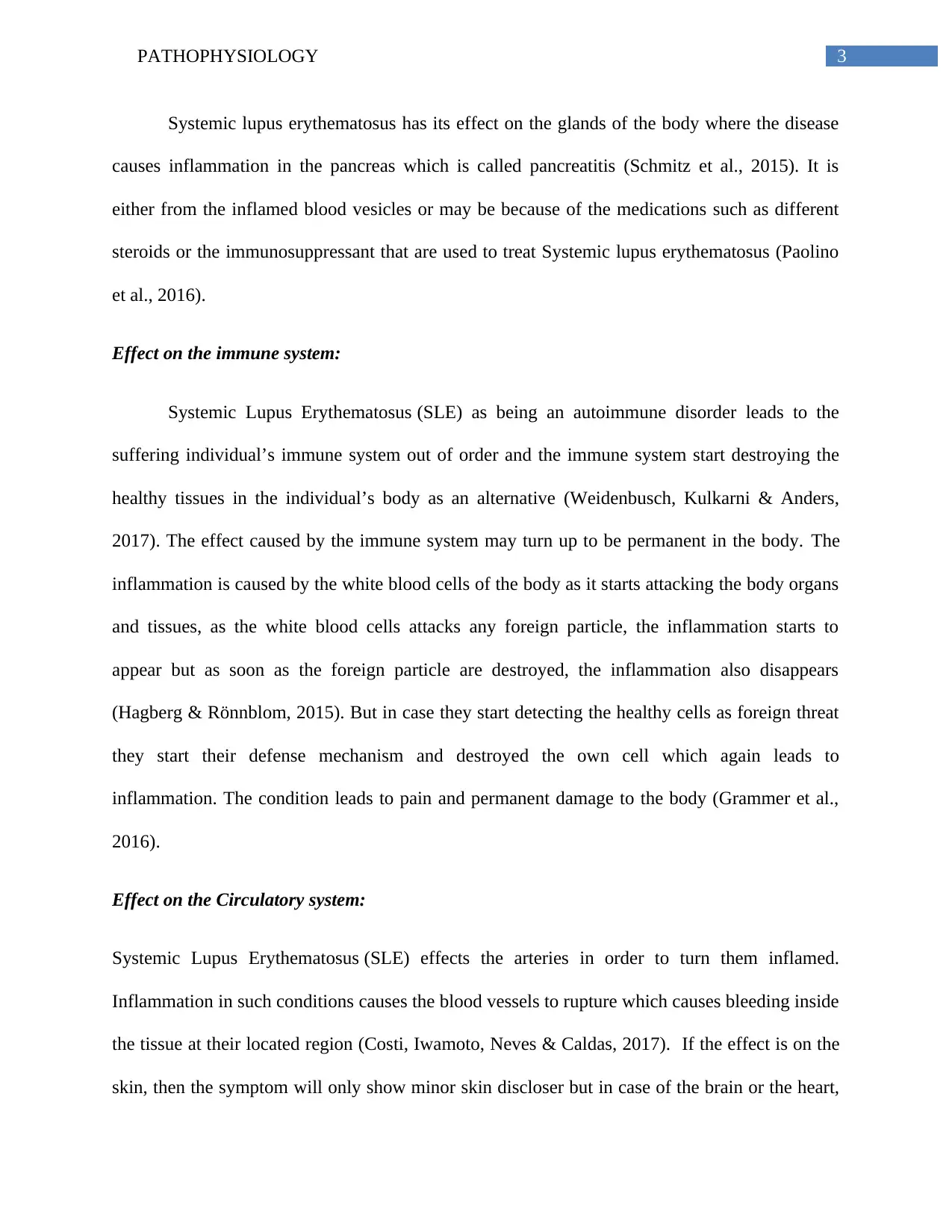
3PATHOPHYSIOLOGY
Systemic lupus erythematosus has its effect on the glands of the body where the disease
causes inflammation in the pancreas which is called pancreatitis (Schmitz et al., 2015). It is
either from the inflamed blood vesicles or may be because of the medications such as different
steroids or the immunosuppressant that are used to treat Systemic lupus erythematosus (Paolino
et al., 2016).
Effect on the immune system:
Systemic Lupus Erythematosus (SLE) as being an autoimmune disorder leads to the
suffering individual’s immune system out of order and the immune system start destroying the
healthy tissues in the individual’s body as an alternative (Weidenbusch, Kulkarni & Anders,
2017). The effect caused by the immune system may turn up to be permanent in the body. The
inflammation is caused by the white blood cells of the body as it starts attacking the body organs
and tissues, as the white blood cells attacks any foreign particle, the inflammation starts to
appear but as soon as the foreign particle are destroyed, the inflammation also disappears
(Hagberg & Rönnblom, 2015). But in case they start detecting the healthy cells as foreign threat
they start their defense mechanism and destroyed the own cell which again leads to
inflammation. The condition leads to pain and permanent damage to the body (Grammer et al.,
2016).
Effect on the Circulatory system:
Systemic Lupus Erythematosus (SLE) effects the arteries in order to turn them inflamed.
Inflammation in such conditions causes the blood vessels to rupture which causes bleeding inside
the tissue at their located region (Costi, Iwamoto, Neves & Caldas, 2017). If the effect is on the
skin, then the symptom will only show minor skin discloser but in case of the brain or the heart,
Systemic lupus erythematosus has its effect on the glands of the body where the disease
causes inflammation in the pancreas which is called pancreatitis (Schmitz et al., 2015). It is
either from the inflamed blood vesicles or may be because of the medications such as different
steroids or the immunosuppressant that are used to treat Systemic lupus erythematosus (Paolino
et al., 2016).
Effect on the immune system:
Systemic Lupus Erythematosus (SLE) as being an autoimmune disorder leads to the
suffering individual’s immune system out of order and the immune system start destroying the
healthy tissues in the individual’s body as an alternative (Weidenbusch, Kulkarni & Anders,
2017). The effect caused by the immune system may turn up to be permanent in the body. The
inflammation is caused by the white blood cells of the body as it starts attacking the body organs
and tissues, as the white blood cells attacks any foreign particle, the inflammation starts to
appear but as soon as the foreign particle are destroyed, the inflammation also disappears
(Hagberg & Rönnblom, 2015). But in case they start detecting the healthy cells as foreign threat
they start their defense mechanism and destroyed the own cell which again leads to
inflammation. The condition leads to pain and permanent damage to the body (Grammer et al.,
2016).
Effect on the Circulatory system:
Systemic Lupus Erythematosus (SLE) effects the arteries in order to turn them inflamed.
Inflammation in such conditions causes the blood vessels to rupture which causes bleeding inside
the tissue at their located region (Costi, Iwamoto, Neves & Caldas, 2017). If the effect is on the
skin, then the symptom will only show minor skin discloser but in case of the brain or the heart,
Secure Best Marks with AI Grader
Need help grading? Try our AI Grader for instant feedback on your assignments.
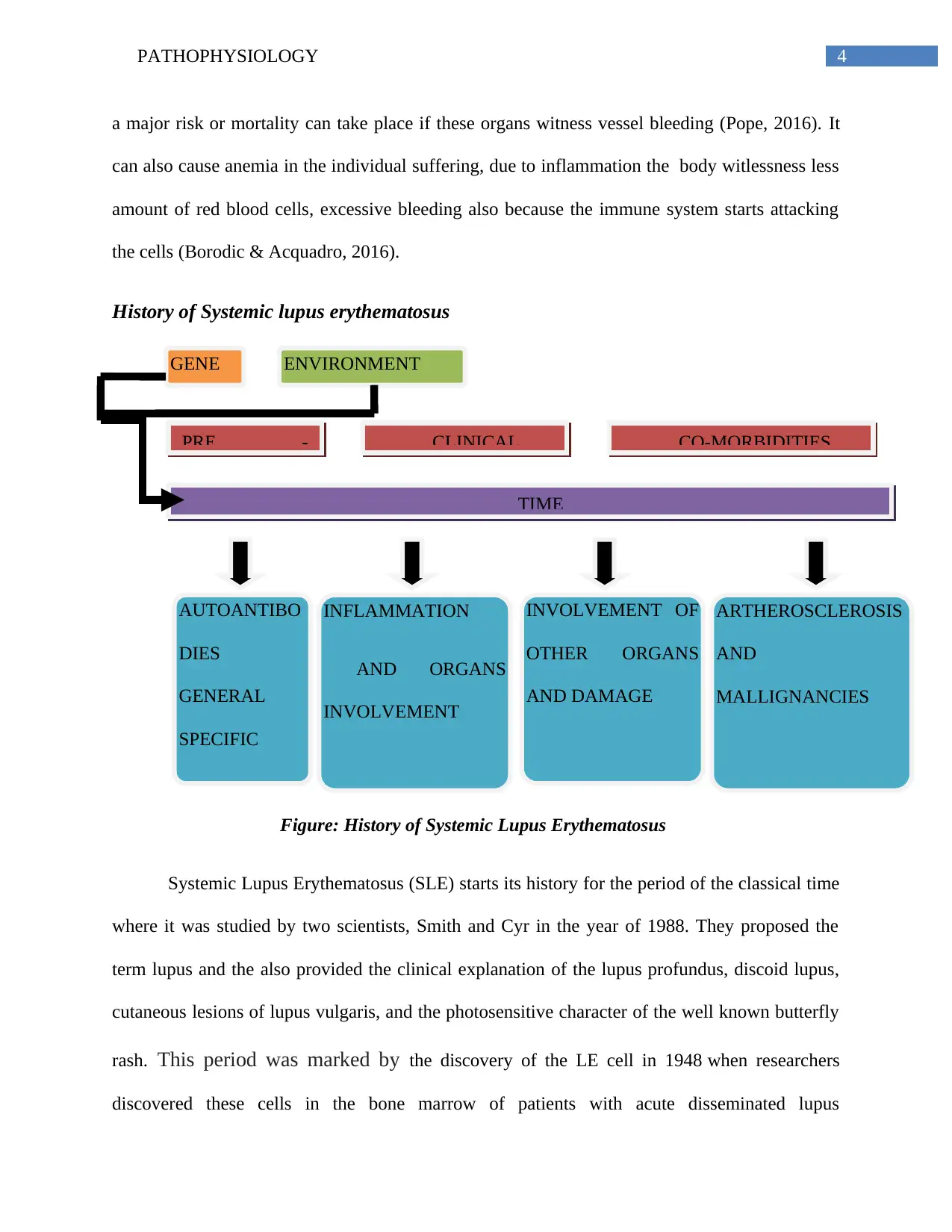
4PATHOPHYSIOLOGY
a major risk or mortality can take place if these organs witness vessel bleeding (Pope, 2016). It
can also cause anemia in the individual suffering, due to inflammation the body witlessness less
amount of red blood cells, excessive bleeding also because the immune system starts attacking
the cells (Borodic & Acquadro, 2016).
History of Systemic lupus erythematosus
Figure: History of Systemic Lupus Erythematosus
Systemic Lupus Erythematosus (SLE) starts its history for the period of the classical time
where it was studied by two scientists, Smith and Cyr in the year of 1988. They proposed the
term lupus and the also provided the clinical explanation of the lupus profundus, discoid lupus,
cutaneous lesions of lupus vulgaris, and the photosensitive character of the well known butterfly
rash. This period was marked by the discovery of the LE cell in 1948 when researchers
discovered these cells in the bone marrow of patients with acute disseminated lupus
GENE ENVIRONMENT
PRE - CLINICAL CO-MORBIDITIES
TIME
AUTOANTIBO
DIES
GENERAL
SPECIFIC
INFLAMMATION
AND ORGANS
INVOLVEMENT
INVOLVEMENT OF
OTHER ORGANS
AND DAMAGE
ARTHEROSCLEROSIS
AND
MALLIGNANCIES
a major risk or mortality can take place if these organs witness vessel bleeding (Pope, 2016). It
can also cause anemia in the individual suffering, due to inflammation the body witlessness less
amount of red blood cells, excessive bleeding also because the immune system starts attacking
the cells (Borodic & Acquadro, 2016).
History of Systemic lupus erythematosus
Figure: History of Systemic Lupus Erythematosus
Systemic Lupus Erythematosus (SLE) starts its history for the period of the classical time
where it was studied by two scientists, Smith and Cyr in the year of 1988. They proposed the
term lupus and the also provided the clinical explanation of the lupus profundus, discoid lupus,
cutaneous lesions of lupus vulgaris, and the photosensitive character of the well known butterfly
rash. This period was marked by the discovery of the LE cell in 1948 when researchers
discovered these cells in the bone marrow of patients with acute disseminated lupus
GENE ENVIRONMENT
PRE - CLINICAL CO-MORBIDITIES
TIME
AUTOANTIBO
DIES
GENERAL
SPECIFIC
INFLAMMATION
AND ORGANS
INVOLVEMENT
INVOLVEMENT OF
OTHER ORGANS
AND DAMAGE
ARTHEROSCLEROSIS
AND
MALLIGNANCIES
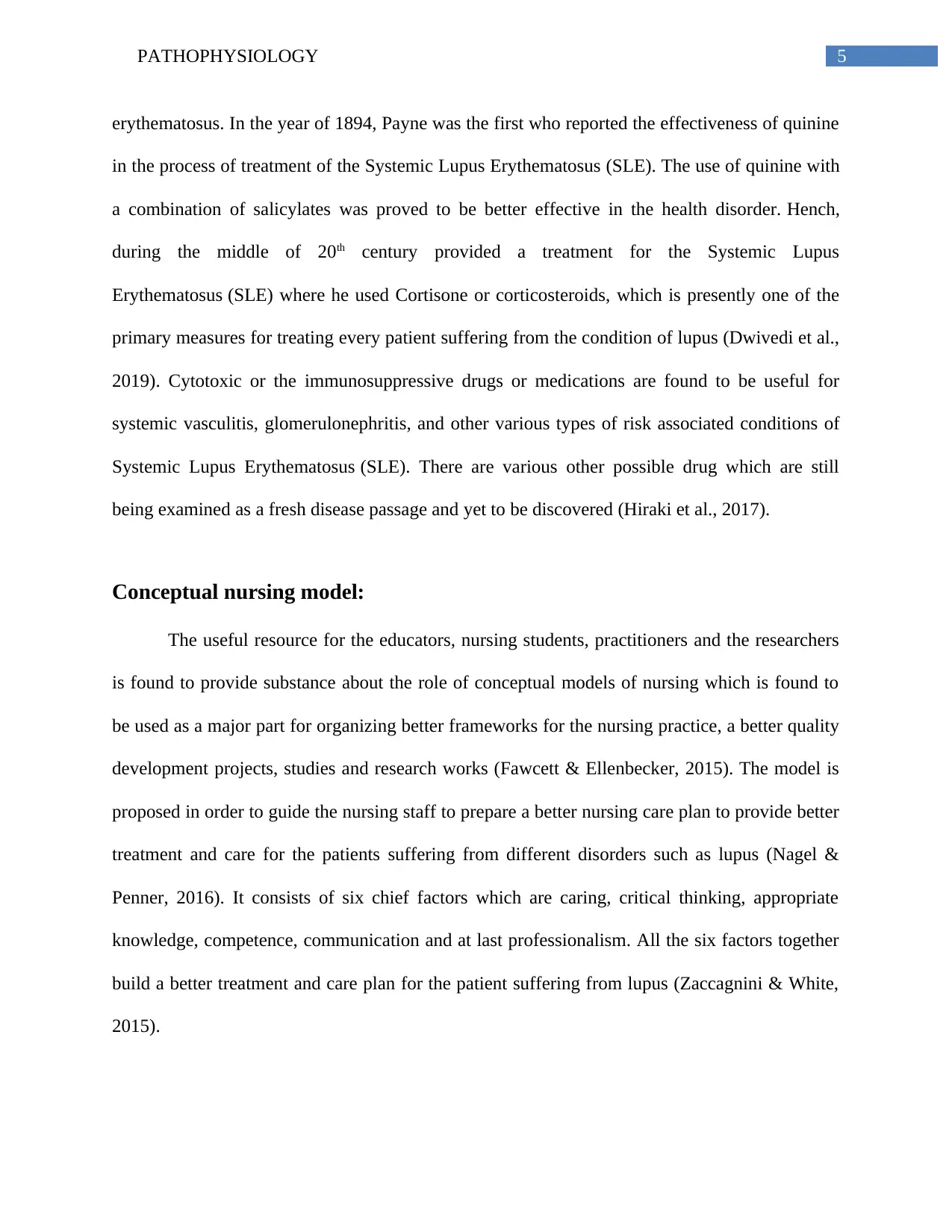
5PATHOPHYSIOLOGY
erythematosus. In the year of 1894, Payne was the first who reported the effectiveness of quinine
in the process of treatment of the Systemic Lupus Erythematosus (SLE). The use of quinine with
a combination of salicylates was proved to be better effective in the health disorder. Hench,
during the middle of 20th century provided a treatment for the Systemic Lupus
Erythematosus (SLE) where he used Cortisone or corticosteroids, which is presently one of the
primary measures for treating every patient suffering from the condition of lupus (Dwivedi et al.,
2019). Cytotoxic or the immunosuppressive drugs or medications are found to be useful for
systemic vasculitis, glomerulonephritis, and other various types of risk associated conditions of
Systemic Lupus Erythematosus (SLE). There are various other possible drug which are still
being examined as a fresh disease passage and yet to be discovered (Hiraki et al., 2017).
Conceptual nursing model:
The useful resource for the educators, nursing students, practitioners and the researchers
is found to provide substance about the role of conceptual models of nursing which is found to
be used as a major part for organizing better frameworks for the nursing practice, a better quality
development projects, studies and research works (Fawcett & Ellenbecker, 2015). The model is
proposed in order to guide the nursing staff to prepare a better nursing care plan to provide better
treatment and care for the patients suffering from different disorders such as lupus (Nagel &
Penner, 2016). It consists of six chief factors which are caring, critical thinking, appropriate
knowledge, competence, communication and at last professionalism. All the six factors together
build a better treatment and care plan for the patient suffering from lupus (Zaccagnini & White,
2015).
erythematosus. In the year of 1894, Payne was the first who reported the effectiveness of quinine
in the process of treatment of the Systemic Lupus Erythematosus (SLE). The use of quinine with
a combination of salicylates was proved to be better effective in the health disorder. Hench,
during the middle of 20th century provided a treatment for the Systemic Lupus
Erythematosus (SLE) where he used Cortisone or corticosteroids, which is presently one of the
primary measures for treating every patient suffering from the condition of lupus (Dwivedi et al.,
2019). Cytotoxic or the immunosuppressive drugs or medications are found to be useful for
systemic vasculitis, glomerulonephritis, and other various types of risk associated conditions of
Systemic Lupus Erythematosus (SLE). There are various other possible drug which are still
being examined as a fresh disease passage and yet to be discovered (Hiraki et al., 2017).
Conceptual nursing model:
The useful resource for the educators, nursing students, practitioners and the researchers
is found to provide substance about the role of conceptual models of nursing which is found to
be used as a major part for organizing better frameworks for the nursing practice, a better quality
development projects, studies and research works (Fawcett & Ellenbecker, 2015). The model is
proposed in order to guide the nursing staff to prepare a better nursing care plan to provide better
treatment and care for the patients suffering from different disorders such as lupus (Nagel &
Penner, 2016). It consists of six chief factors which are caring, critical thinking, appropriate
knowledge, competence, communication and at last professionalism. All the six factors together
build a better treatment and care plan for the patient suffering from lupus (Zaccagnini & White,
2015).
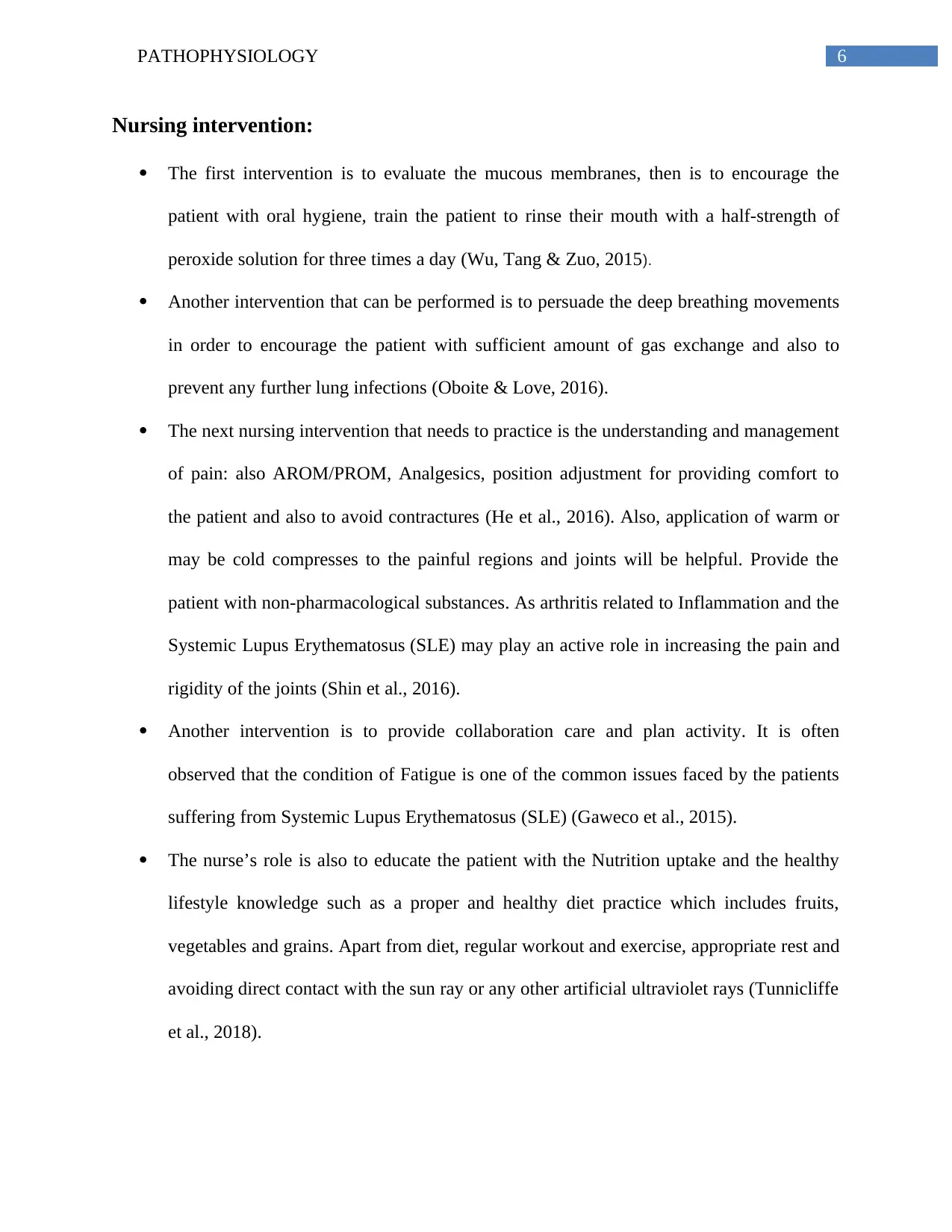
6PATHOPHYSIOLOGY
Nursing intervention:
The first intervention is to evaluate the mucous membranes, then is to encourage the
patient with oral hygiene, train the patient to rinse their mouth with a half-strength of
peroxide solution for three times a day (Wu, Tang & Zuo, 2015).
Another intervention that can be performed is to persuade the deep breathing movements
in order to encourage the patient with sufficient amount of gas exchange and also to
prevent any further lung infections (Oboite & Love, 2016).
The next nursing intervention that needs to practice is the understanding and management
of pain: also AROM/PROM, Analgesics, position adjustment for providing comfort to
the patient and also to avoid contractures (He et al., 2016). Also, application of warm or
may be cold compresses to the painful regions and joints will be helpful. Provide the
patient with non-pharmacological substances. As arthritis related to Inflammation and the
Systemic Lupus Erythematosus (SLE) may play an active role in increasing the pain and
rigidity of the joints (Shin et al., 2016).
Another intervention is to provide collaboration care and plan activity. It is often
observed that the condition of Fatigue is one of the common issues faced by the patients
suffering from Systemic Lupus Erythematosus (SLE) (Gaweco et al., 2015).
The nurse’s role is also to educate the patient with the Nutrition uptake and the healthy
lifestyle knowledge such as a proper and healthy diet practice which includes fruits,
vegetables and grains. Apart from diet, regular workout and exercise, appropriate rest and
avoiding direct contact with the sun ray or any other artificial ultraviolet rays (Tunnicliffe
et al., 2018).
Nursing intervention:
The first intervention is to evaluate the mucous membranes, then is to encourage the
patient with oral hygiene, train the patient to rinse their mouth with a half-strength of
peroxide solution for three times a day (Wu, Tang & Zuo, 2015).
Another intervention that can be performed is to persuade the deep breathing movements
in order to encourage the patient with sufficient amount of gas exchange and also to
prevent any further lung infections (Oboite & Love, 2016).
The next nursing intervention that needs to practice is the understanding and management
of pain: also AROM/PROM, Analgesics, position adjustment for providing comfort to
the patient and also to avoid contractures (He et al., 2016). Also, application of warm or
may be cold compresses to the painful regions and joints will be helpful. Provide the
patient with non-pharmacological substances. As arthritis related to Inflammation and the
Systemic Lupus Erythematosus (SLE) may play an active role in increasing the pain and
rigidity of the joints (Shin et al., 2016).
Another intervention is to provide collaboration care and plan activity. It is often
observed that the condition of Fatigue is one of the common issues faced by the patients
suffering from Systemic Lupus Erythematosus (SLE) (Gaweco et al., 2015).
The nurse’s role is also to educate the patient with the Nutrition uptake and the healthy
lifestyle knowledge such as a proper and healthy diet practice which includes fruits,
vegetables and grains. Apart from diet, regular workout and exercise, appropriate rest and
avoiding direct contact with the sun ray or any other artificial ultraviolet rays (Tunnicliffe
et al., 2018).
Paraphrase This Document
Need a fresh take? Get an instant paraphrase of this document with our AI Paraphraser
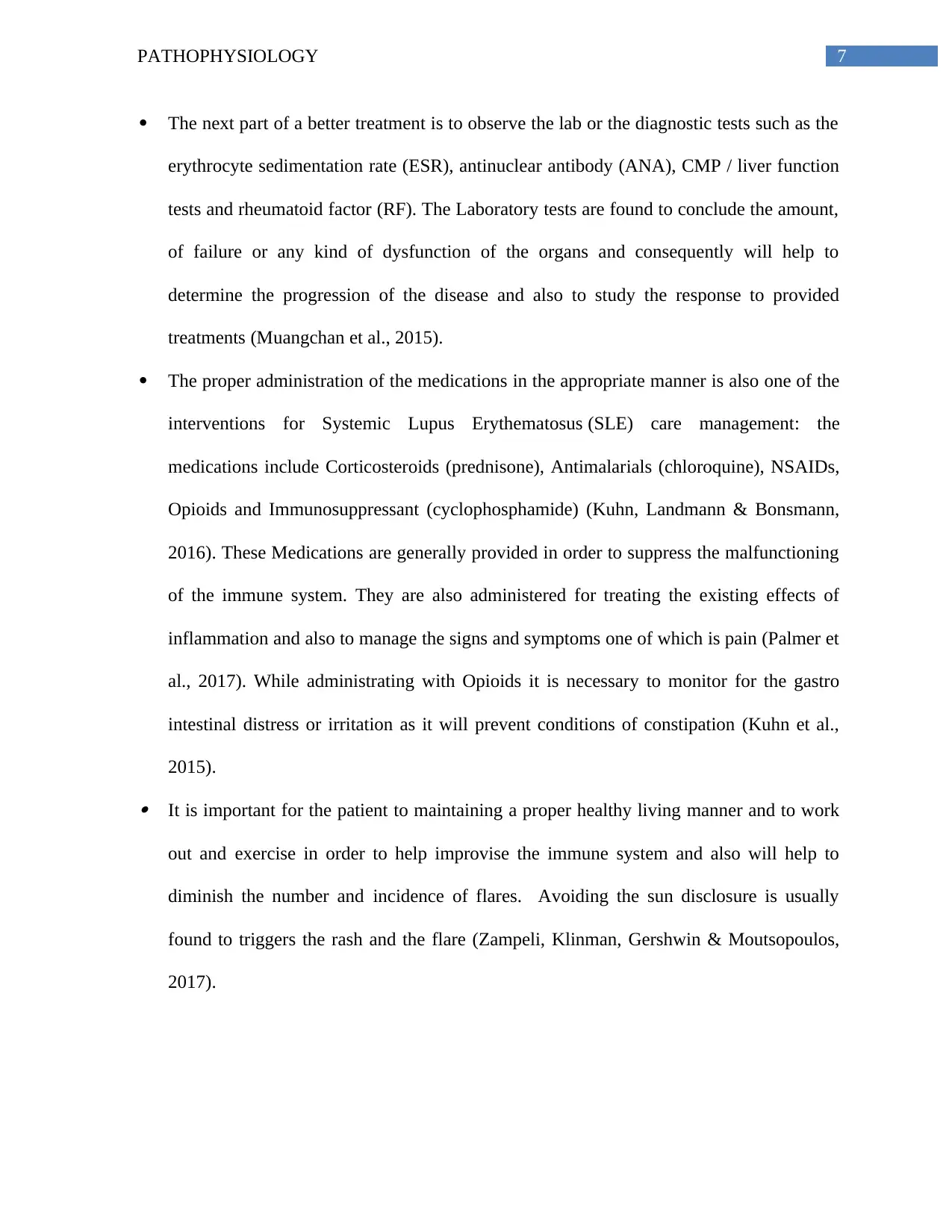
7PATHOPHYSIOLOGY
The next part of a better treatment is to observe the lab or the diagnostic tests such as the
erythrocyte sedimentation rate (ESR), antinuclear antibody (ANA), CMP / liver function
tests and rheumatoid factor (RF). The Laboratory tests are found to conclude the amount,
of failure or any kind of dysfunction of the organs and consequently will help to
determine the progression of the disease and also to study the response to provided
treatments (Muangchan et al., 2015).
The proper administration of the medications in the appropriate manner is also one of the
interventions for Systemic Lupus Erythematosus (SLE) care management: the
medications include Corticosteroids (prednisone), Antimalarials (chloroquine), NSAIDs,
Opioids and Immunosuppressant (cyclophosphamide) (Kuhn, Landmann & Bonsmann,
2016). These Medications are generally provided in order to suppress the malfunctioning
of the immune system. They are also administered for treating the existing effects of
inflammation and also to manage the signs and symptoms one of which is pain (Palmer et
al., 2017). While administrating with Opioids it is necessary to monitor for the gastro
intestinal distress or irritation as it will prevent conditions of constipation (Kuhn et al.,
2015). It is important for the patient to maintaining a proper healthy living manner and to work
out and exercise in order to help improvise the immune system and also will help to
diminish the number and incidence of flares. Avoiding the sun disclosure is usually
found to triggers the rash and the flare (Zampeli, Klinman, Gershwin & Moutsopoulos,
2017).
The next part of a better treatment is to observe the lab or the diagnostic tests such as the
erythrocyte sedimentation rate (ESR), antinuclear antibody (ANA), CMP / liver function
tests and rheumatoid factor (RF). The Laboratory tests are found to conclude the amount,
of failure or any kind of dysfunction of the organs and consequently will help to
determine the progression of the disease and also to study the response to provided
treatments (Muangchan et al., 2015).
The proper administration of the medications in the appropriate manner is also one of the
interventions for Systemic Lupus Erythematosus (SLE) care management: the
medications include Corticosteroids (prednisone), Antimalarials (chloroquine), NSAIDs,
Opioids and Immunosuppressant (cyclophosphamide) (Kuhn, Landmann & Bonsmann,
2016). These Medications are generally provided in order to suppress the malfunctioning
of the immune system. They are also administered for treating the existing effects of
inflammation and also to manage the signs and symptoms one of which is pain (Palmer et
al., 2017). While administrating with Opioids it is necessary to monitor for the gastro
intestinal distress or irritation as it will prevent conditions of constipation (Kuhn et al.,
2015). It is important for the patient to maintaining a proper healthy living manner and to work
out and exercise in order to help improvise the immune system and also will help to
diminish the number and incidence of flares. Avoiding the sun disclosure is usually
found to triggers the rash and the flare (Zampeli, Klinman, Gershwin & Moutsopoulos,
2017).
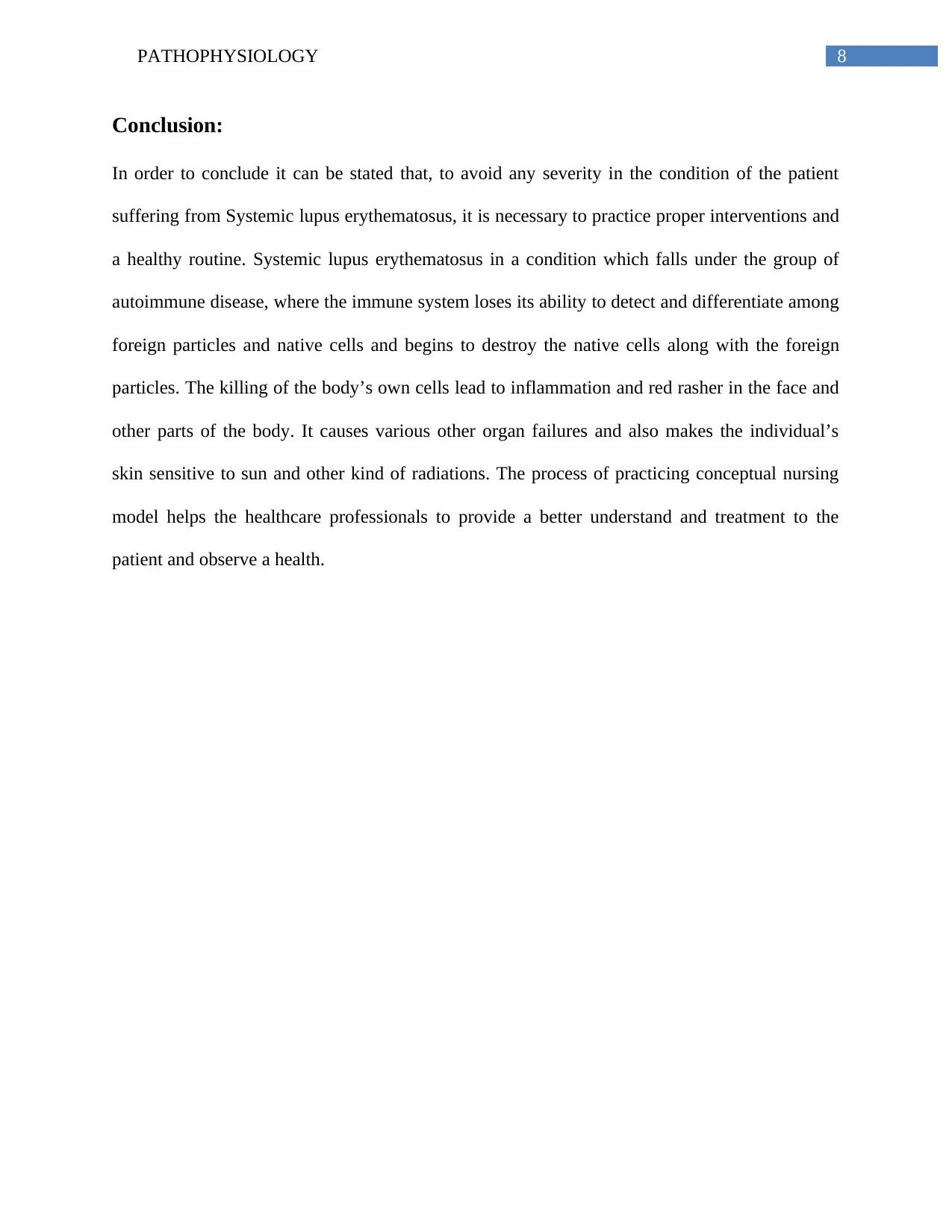
8PATHOPHYSIOLOGY
Conclusion:
In order to conclude it can be stated that, to avoid any severity in the condition of the patient
suffering from Systemic lupus erythematosus, it is necessary to practice proper interventions and
a healthy routine. Systemic lupus erythematosus in a condition which falls under the group of
autoimmune disease, where the immune system loses its ability to detect and differentiate among
foreign particles and native cells and begins to destroy the native cells along with the foreign
particles. The killing of the body’s own cells lead to inflammation and red rasher in the face and
other parts of the body. It causes various other organ failures and also makes the individual’s
skin sensitive to sun and other kind of radiations. The process of practicing conceptual nursing
model helps the healthcare professionals to provide a better understand and treatment to the
patient and observe a health.
Conclusion:
In order to conclude it can be stated that, to avoid any severity in the condition of the patient
suffering from Systemic lupus erythematosus, it is necessary to practice proper interventions and
a healthy routine. Systemic lupus erythematosus in a condition which falls under the group of
autoimmune disease, where the immune system loses its ability to detect and differentiate among
foreign particles and native cells and begins to destroy the native cells along with the foreign
particles. The killing of the body’s own cells lead to inflammation and red rasher in the face and
other parts of the body. It causes various other organ failures and also makes the individual’s
skin sensitive to sun and other kind of radiations. The process of practicing conceptual nursing
model helps the healthcare professionals to provide a better understand and treatment to the
patient and observe a health.

9PATHOPHYSIOLOGY
Reference:
Ayyappan, P., Harms, R. Z., Buckner, J. H., & Sarvetnick, N. E. (2019). Coordinated Induction
of Antimicrobial Response Factors in Systemic Lupus Erythematosus. Frontiers in
immunology, 10, 658.
Bentham, J., Morris, D. L., Graham, D. S. C., Pinder, C. L., Tombleson, P., Behrens, T. W., ... &
Replogle, J. (2015). Genetic association analyses implicate aberrant regulation of innate
and adaptive immunity genes in the pathogenesis of systemic lupus
erythematosus. Nature genetics, 47(12), 1457.
Borodic, G. E., & Acquadro, M. A. (2016). U.S. Patent No. 9,393,291. Washington, DC: U.S.
Patent and Trademark Office.
Bruce, I. N., O'keeffe, A. G., Farewell, V., Hanly, J. G., Manzi, S., Su, L., ... & Gordon, C.
(2015). Factors associated with damage accrual in patients with systemic lupus
erythematosus: results from the Systemic Lupus International Collaborating Clinics
(SLICC) Inception Cohort. Annals of the rheumatic diseases, 74(9), 1706-1713.
Chalmers, S. A., Wen, J., Doerner, J. L., Stock, A. D., Webb, D., Herlitz, L., ... & Ramanujam,
M. (2018). BTK inhibition ameliorates renal, skin, and brain disease in a spontaneous
murine model of systemic lupus erythematosus.
Chamberlain, C., Colman, P. J., Ranger, A. M., Burkly, L. C., Johnston, G. I., Otoul, C., ... &
Hiepe, F. (2017). Repeated administration of dapirolizumab pegol in a randomised phase
I study is well tolerated and accompanied by improvements in several composite
Reference:
Ayyappan, P., Harms, R. Z., Buckner, J. H., & Sarvetnick, N. E. (2019). Coordinated Induction
of Antimicrobial Response Factors in Systemic Lupus Erythematosus. Frontiers in
immunology, 10, 658.
Bentham, J., Morris, D. L., Graham, D. S. C., Pinder, C. L., Tombleson, P., Behrens, T. W., ... &
Replogle, J. (2015). Genetic association analyses implicate aberrant regulation of innate
and adaptive immunity genes in the pathogenesis of systemic lupus
erythematosus. Nature genetics, 47(12), 1457.
Borodic, G. E., & Acquadro, M. A. (2016). U.S. Patent No. 9,393,291. Washington, DC: U.S.
Patent and Trademark Office.
Bruce, I. N., O'keeffe, A. G., Farewell, V., Hanly, J. G., Manzi, S., Su, L., ... & Gordon, C.
(2015). Factors associated with damage accrual in patients with systemic lupus
erythematosus: results from the Systemic Lupus International Collaborating Clinics
(SLICC) Inception Cohort. Annals of the rheumatic diseases, 74(9), 1706-1713.
Chalmers, S. A., Wen, J., Doerner, J. L., Stock, A. D., Webb, D., Herlitz, L., ... & Ramanujam,
M. (2018). BTK inhibition ameliorates renal, skin, and brain disease in a spontaneous
murine model of systemic lupus erythematosus.
Chamberlain, C., Colman, P. J., Ranger, A. M., Burkly, L. C., Johnston, G. I., Otoul, C., ... &
Hiepe, F. (2017). Repeated administration of dapirolizumab pegol in a randomised phase
I study is well tolerated and accompanied by improvements in several composite
Secure Best Marks with AI Grader
Need help grading? Try our AI Grader for instant feedback on your assignments.
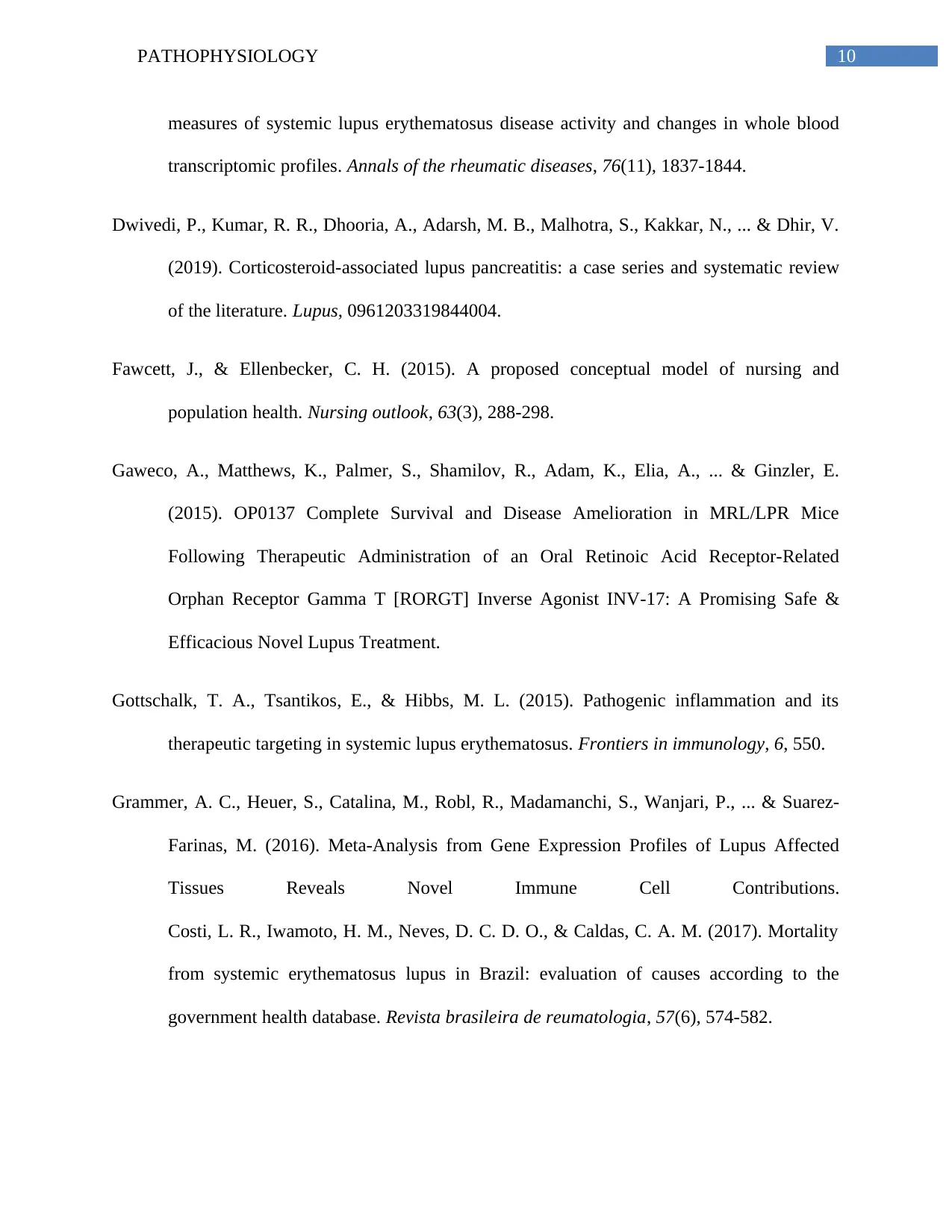
10PATHOPHYSIOLOGY
measures of systemic lupus erythematosus disease activity and changes in whole blood
transcriptomic profiles. Annals of the rheumatic diseases, 76(11), 1837-1844.
Dwivedi, P., Kumar, R. R., Dhooria, A., Adarsh, M. B., Malhotra, S., Kakkar, N., ... & Dhir, V.
(2019). Corticosteroid-associated lupus pancreatitis: a case series and systematic review
of the literature. Lupus, 0961203319844004.
Fawcett, J., & Ellenbecker, C. H. (2015). A proposed conceptual model of nursing and
population health. Nursing outlook, 63(3), 288-298.
Gaweco, A., Matthews, K., Palmer, S., Shamilov, R., Adam, K., Elia, A., ... & Ginzler, E.
(2015). OP0137 Complete Survival and Disease Amelioration in MRL/LPR Mice
Following Therapeutic Administration of an Oral Retinoic Acid Receptor-Related
Orphan Receptor Gamma T [RORGT] Inverse Agonist INV-17: A Promising Safe &
Efficacious Novel Lupus Treatment.
Gottschalk, T. A., Tsantikos, E., & Hibbs, M. L. (2015). Pathogenic inflammation and its
therapeutic targeting in systemic lupus erythematosus. Frontiers in immunology, 6, 550.
Grammer, A. C., Heuer, S., Catalina, M., Robl, R., Madamanchi, S., Wanjari, P., ... & Suarez-
Farinas, M. (2016). Meta-Analysis from Gene Expression Profiles of Lupus Affected
Tissues Reveals Novel Immune Cell Contributions.
Costi, L. R., Iwamoto, H. M., Neves, D. C. D. O., & Caldas, C. A. M. (2017). Mortality
from systemic erythematosus lupus in Brazil: evaluation of causes according to the
government health database. Revista brasileira de reumatologia, 57(6), 574-582.
measures of systemic lupus erythematosus disease activity and changes in whole blood
transcriptomic profiles. Annals of the rheumatic diseases, 76(11), 1837-1844.
Dwivedi, P., Kumar, R. R., Dhooria, A., Adarsh, M. B., Malhotra, S., Kakkar, N., ... & Dhir, V.
(2019). Corticosteroid-associated lupus pancreatitis: a case series and systematic review
of the literature. Lupus, 0961203319844004.
Fawcett, J., & Ellenbecker, C. H. (2015). A proposed conceptual model of nursing and
population health. Nursing outlook, 63(3), 288-298.
Gaweco, A., Matthews, K., Palmer, S., Shamilov, R., Adam, K., Elia, A., ... & Ginzler, E.
(2015). OP0137 Complete Survival and Disease Amelioration in MRL/LPR Mice
Following Therapeutic Administration of an Oral Retinoic Acid Receptor-Related
Orphan Receptor Gamma T [RORGT] Inverse Agonist INV-17: A Promising Safe &
Efficacious Novel Lupus Treatment.
Gottschalk, T. A., Tsantikos, E., & Hibbs, M. L. (2015). Pathogenic inflammation and its
therapeutic targeting in systemic lupus erythematosus. Frontiers in immunology, 6, 550.
Grammer, A. C., Heuer, S., Catalina, M., Robl, R., Madamanchi, S., Wanjari, P., ... & Suarez-
Farinas, M. (2016). Meta-Analysis from Gene Expression Profiles of Lupus Affected
Tissues Reveals Novel Immune Cell Contributions.
Costi, L. R., Iwamoto, H. M., Neves, D. C. D. O., & Caldas, C. A. M. (2017). Mortality
from systemic erythematosus lupus in Brazil: evaluation of causes according to the
government health database. Revista brasileira de reumatologia, 57(6), 574-582.
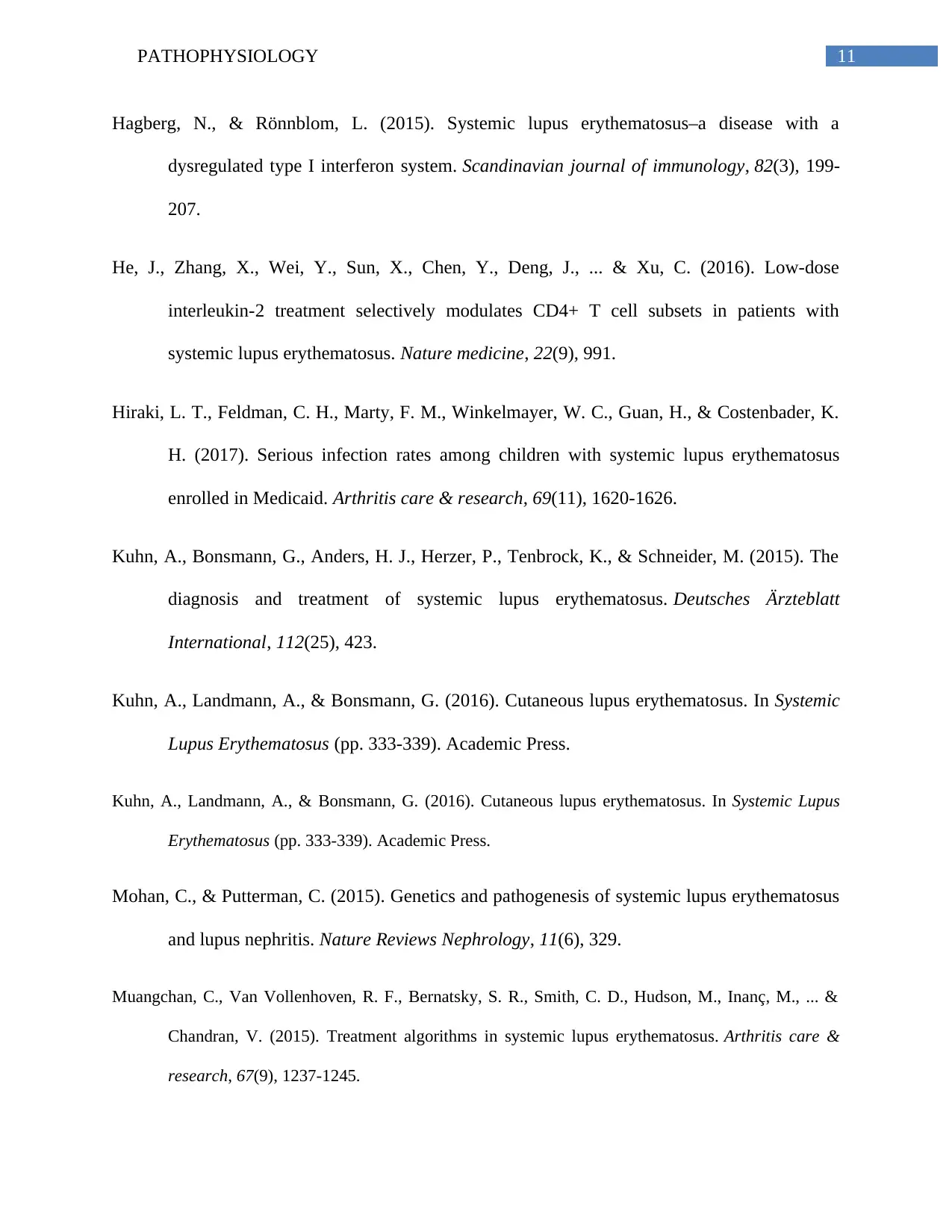
11PATHOPHYSIOLOGY
Hagberg, N., & Rönnblom, L. (2015). Systemic lupus erythematosus–a disease with a
dysregulated type I interferon system. Scandinavian journal of immunology, 82(3), 199-
207.
He, J., Zhang, X., Wei, Y., Sun, X., Chen, Y., Deng, J., ... & Xu, C. (2016). Low-dose
interleukin-2 treatment selectively modulates CD4+ T cell subsets in patients with
systemic lupus erythematosus. Nature medicine, 22(9), 991.
Hiraki, L. T., Feldman, C. H., Marty, F. M., Winkelmayer, W. C., Guan, H., & Costenbader, K.
H. (2017). Serious infection rates among children with systemic lupus erythematosus
enrolled in Medicaid. Arthritis care & research, 69(11), 1620-1626.
Kuhn, A., Bonsmann, G., Anders, H. J., Herzer, P., Tenbrock, K., & Schneider, M. (2015). The
diagnosis and treatment of systemic lupus erythematosus. Deutsches Ärzteblatt
International, 112(25), 423.
Kuhn, A., Landmann, A., & Bonsmann, G. (2016). Cutaneous lupus erythematosus. In Systemic
Lupus Erythematosus (pp. 333-339). Academic Press.
Kuhn, A., Landmann, A., & Bonsmann, G. (2016). Cutaneous lupus erythematosus. In Systemic Lupus
Erythematosus (pp. 333-339). Academic Press.
Mohan, C., & Putterman, C. (2015). Genetics and pathogenesis of systemic lupus erythematosus
and lupus nephritis. Nature Reviews Nephrology, 11(6), 329.
Muangchan, C., Van Vollenhoven, R. F., Bernatsky, S. R., Smith, C. D., Hudson, M., Inanç, M., ... &
Chandran, V. (2015). Treatment algorithms in systemic lupus erythematosus. Arthritis care &
research, 67(9), 1237-1245.
Hagberg, N., & Rönnblom, L. (2015). Systemic lupus erythematosus–a disease with a
dysregulated type I interferon system. Scandinavian journal of immunology, 82(3), 199-
207.
He, J., Zhang, X., Wei, Y., Sun, X., Chen, Y., Deng, J., ... & Xu, C. (2016). Low-dose
interleukin-2 treatment selectively modulates CD4+ T cell subsets in patients with
systemic lupus erythematosus. Nature medicine, 22(9), 991.
Hiraki, L. T., Feldman, C. H., Marty, F. M., Winkelmayer, W. C., Guan, H., & Costenbader, K.
H. (2017). Serious infection rates among children with systemic lupus erythematosus
enrolled in Medicaid. Arthritis care & research, 69(11), 1620-1626.
Kuhn, A., Bonsmann, G., Anders, H. J., Herzer, P., Tenbrock, K., & Schneider, M. (2015). The
diagnosis and treatment of systemic lupus erythematosus. Deutsches Ärzteblatt
International, 112(25), 423.
Kuhn, A., Landmann, A., & Bonsmann, G. (2016). Cutaneous lupus erythematosus. In Systemic
Lupus Erythematosus (pp. 333-339). Academic Press.
Kuhn, A., Landmann, A., & Bonsmann, G. (2016). Cutaneous lupus erythematosus. In Systemic Lupus
Erythematosus (pp. 333-339). Academic Press.
Mohan, C., & Putterman, C. (2015). Genetics and pathogenesis of systemic lupus erythematosus
and lupus nephritis. Nature Reviews Nephrology, 11(6), 329.
Muangchan, C., Van Vollenhoven, R. F., Bernatsky, S. R., Smith, C. D., Hudson, M., Inanç, M., ... &
Chandran, V. (2015). Treatment algorithms in systemic lupus erythematosus. Arthritis care &
research, 67(9), 1237-1245.

12PATHOPHYSIOLOGY
Nagel, D. A., & Penner, J. L. (2016). Conceptualizing telehealth in nursing practice: advancing a
conceptual model to fill a virtual gap. Journal of holistic nursing, 34(1), 91-104.
Oboite, M. E., & Love, P. B. (2016). Discoid Lupus Erythematosus. In Clinical Cases in Skin of
Color (pp. 3-13). Springer, Cham.
Oon, S., Huynh, H., Tai, T. Y., Ng, M., Monaghan, K., Biondo, M., ... & Wilson, N. J. (2016). A
cytotoxic anti-IL-3Rα antibody targets key cells and cytokines implicated in systemic
lupus erythematosus. JCI insight, 1(6).
Palmer, S. C., Tunnicliffe, D. J., Singh-Grewal, D., Mavridis, D., Tonelli, M., Johnson, D. W., ... &
Strippoli, G. F. (2017). Induction and maintenance immunosuppression treatment of proliferative
lupus nephritis: a network meta-analysis of randomized trials. American Journal of Kidney
Diseases, 70(3), 324-336.
Paolino, S., Smith, V., Pizzorni, C., Seriolo, B., Sulli, A., & Cutolo, M. (2016). Vitamin D,
Autoimmune Diseases, and Systemic Lupus Erythematosus. In Connective Tissue
Disease (pp. 159-168). Springer, Cham.
Pope, J. (2016). Systemic Lupus Erythematosus (SLE). ESSAI, 14(1), 31.
Rees, F., Doherty, M., Grainge, M., Davenport, G., Lanyon, P., & Zhang, W. (2016). The
incidence and prevalence of systemic lupus erythematosus in the UK, 1999–2012. Annals
of the rheumatic diseases, 75(1), 136-141.
Schmitz, M. K., Botte, D. A., Sotto, M. N., Borba, E. F., Bonfa, E., & de Mello, S. B. V. (2015).
Increased corticotropin-releasing hormone (CRH) expression in cutaneous lupus
lesions. Lupus, 24(8), 854-861.
Nagel, D. A., & Penner, J. L. (2016). Conceptualizing telehealth in nursing practice: advancing a
conceptual model to fill a virtual gap. Journal of holistic nursing, 34(1), 91-104.
Oboite, M. E., & Love, P. B. (2016). Discoid Lupus Erythematosus. In Clinical Cases in Skin of
Color (pp. 3-13). Springer, Cham.
Oon, S., Huynh, H., Tai, T. Y., Ng, M., Monaghan, K., Biondo, M., ... & Wilson, N. J. (2016). A
cytotoxic anti-IL-3Rα antibody targets key cells and cytokines implicated in systemic
lupus erythematosus. JCI insight, 1(6).
Palmer, S. C., Tunnicliffe, D. J., Singh-Grewal, D., Mavridis, D., Tonelli, M., Johnson, D. W., ... &
Strippoli, G. F. (2017). Induction and maintenance immunosuppression treatment of proliferative
lupus nephritis: a network meta-analysis of randomized trials. American Journal of Kidney
Diseases, 70(3), 324-336.
Paolino, S., Smith, V., Pizzorni, C., Seriolo, B., Sulli, A., & Cutolo, M. (2016). Vitamin D,
Autoimmune Diseases, and Systemic Lupus Erythematosus. In Connective Tissue
Disease (pp. 159-168). Springer, Cham.
Pope, J. (2016). Systemic Lupus Erythematosus (SLE). ESSAI, 14(1), 31.
Rees, F., Doherty, M., Grainge, M., Davenport, G., Lanyon, P., & Zhang, W. (2016). The
incidence and prevalence of systemic lupus erythematosus in the UK, 1999–2012. Annals
of the rheumatic diseases, 75(1), 136-141.
Schmitz, M. K., Botte, D. A., Sotto, M. N., Borba, E. F., Bonfa, E., & de Mello, S. B. V. (2015).
Increased corticotropin-releasing hormone (CRH) expression in cutaneous lupus
lesions. Lupus, 24(8), 854-861.
Paraphrase This Document
Need a fresh take? Get an instant paraphrase of this document with our AI Paraphraser
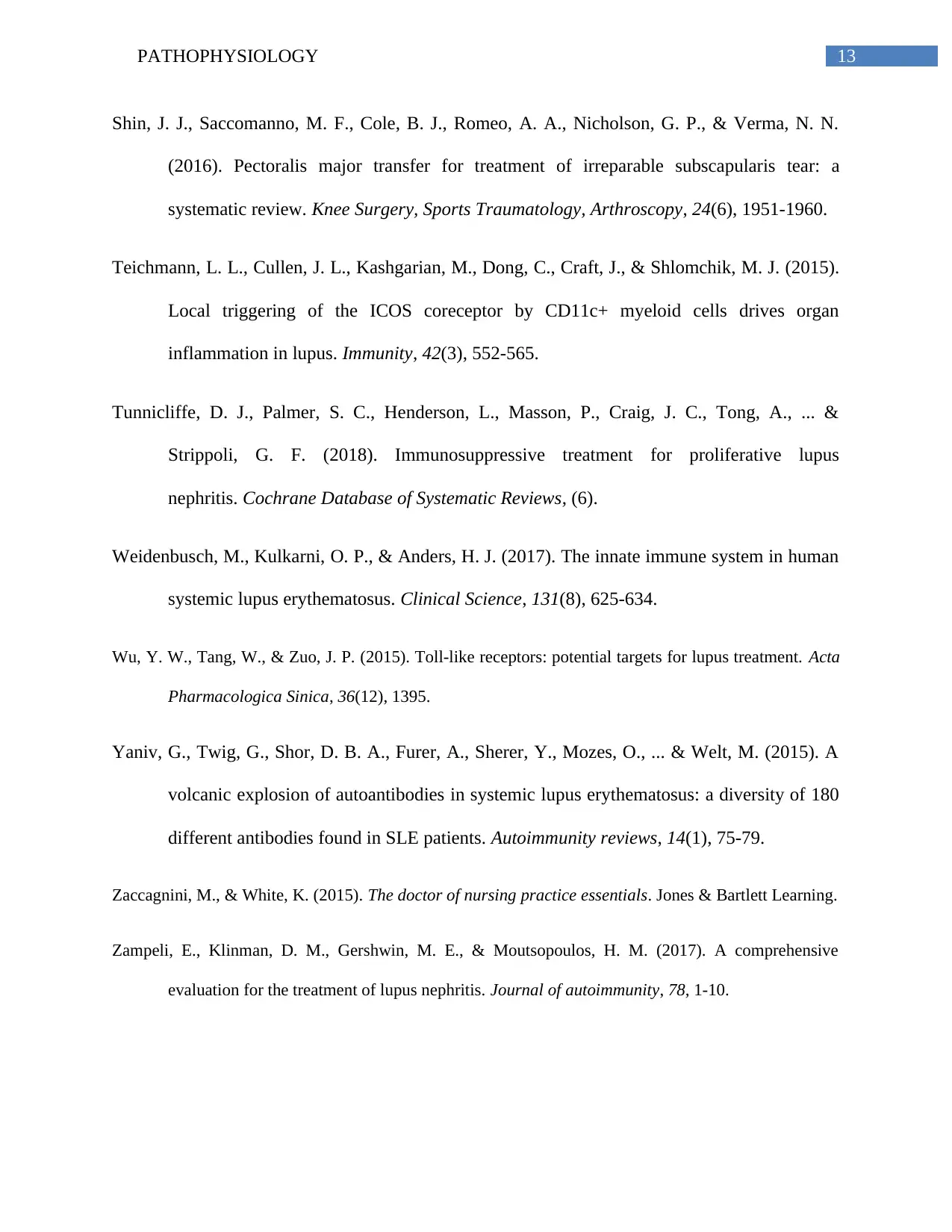
13PATHOPHYSIOLOGY
Shin, J. J., Saccomanno, M. F., Cole, B. J., Romeo, A. A., Nicholson, G. P., & Verma, N. N.
(2016). Pectoralis major transfer for treatment of irreparable subscapularis tear: a
systematic review. Knee Surgery, Sports Traumatology, Arthroscopy, 24(6), 1951-1960.
Teichmann, L. L., Cullen, J. L., Kashgarian, M., Dong, C., Craft, J., & Shlomchik, M. J. (2015).
Local triggering of the ICOS coreceptor by CD11c+ myeloid cells drives organ
inflammation in lupus. Immunity, 42(3), 552-565.
Tunnicliffe, D. J., Palmer, S. C., Henderson, L., Masson, P., Craig, J. C., Tong, A., ... &
Strippoli, G. F. (2018). Immunosuppressive treatment for proliferative lupus
nephritis. Cochrane Database of Systematic Reviews, (6).
Weidenbusch, M., Kulkarni, O. P., & Anders, H. J. (2017). The innate immune system in human
systemic lupus erythematosus. Clinical Science, 131(8), 625-634.
Wu, Y. W., Tang, W., & Zuo, J. P. (2015). Toll-like receptors: potential targets for lupus treatment. Acta
Pharmacologica Sinica, 36(12), 1395.
Yaniv, G., Twig, G., Shor, D. B. A., Furer, A., Sherer, Y., Mozes, O., ... & Welt, M. (2015). A
volcanic explosion of autoantibodies in systemic lupus erythematosus: a diversity of 180
different antibodies found in SLE patients. Autoimmunity reviews, 14(1), 75-79.
Zaccagnini, M., & White, K. (2015). The doctor of nursing practice essentials. Jones & Bartlett Learning.
Zampeli, E., Klinman, D. M., Gershwin, M. E., & Moutsopoulos, H. M. (2017). A comprehensive
evaluation for the treatment of lupus nephritis. Journal of autoimmunity, 78, 1-10.
Shin, J. J., Saccomanno, M. F., Cole, B. J., Romeo, A. A., Nicholson, G. P., & Verma, N. N.
(2016). Pectoralis major transfer for treatment of irreparable subscapularis tear: a
systematic review. Knee Surgery, Sports Traumatology, Arthroscopy, 24(6), 1951-1960.
Teichmann, L. L., Cullen, J. L., Kashgarian, M., Dong, C., Craft, J., & Shlomchik, M. J. (2015).
Local triggering of the ICOS coreceptor by CD11c+ myeloid cells drives organ
inflammation in lupus. Immunity, 42(3), 552-565.
Tunnicliffe, D. J., Palmer, S. C., Henderson, L., Masson, P., Craig, J. C., Tong, A., ... &
Strippoli, G. F. (2018). Immunosuppressive treatment for proliferative lupus
nephritis. Cochrane Database of Systematic Reviews, (6).
Weidenbusch, M., Kulkarni, O. P., & Anders, H. J. (2017). The innate immune system in human
systemic lupus erythematosus. Clinical Science, 131(8), 625-634.
Wu, Y. W., Tang, W., & Zuo, J. P. (2015). Toll-like receptors: potential targets for lupus treatment. Acta
Pharmacologica Sinica, 36(12), 1395.
Yaniv, G., Twig, G., Shor, D. B. A., Furer, A., Sherer, Y., Mozes, O., ... & Welt, M. (2015). A
volcanic explosion of autoantibodies in systemic lupus erythematosus: a diversity of 180
different antibodies found in SLE patients. Autoimmunity reviews, 14(1), 75-79.
Zaccagnini, M., & White, K. (2015). The doctor of nursing practice essentials. Jones & Bartlett Learning.
Zampeli, E., Klinman, D. M., Gershwin, M. E., & Moutsopoulos, H. M. (2017). A comprehensive
evaluation for the treatment of lupus nephritis. Journal of autoimmunity, 78, 1-10.

14PATHOPHYSIOLOGY
Zheng, C. Z., Shu, Y. B., Luo, Y. L., & Luo, J. (2017). The role of miR-146a in modulating
TRAF6-induced inflammation during lupus nephritis. Eur Rev Med Pharmacol
Sci, 21(5), 1041-1048.
Zheng, C. Z., Shu, Y. B., Luo, Y. L., & Luo, J. (2017). The role of miR-146a in modulating
TRAF6-induced inflammation during lupus nephritis. Eur Rev Med Pharmacol
Sci, 21(5), 1041-1048.
1 out of 15
Related Documents
Your All-in-One AI-Powered Toolkit for Academic Success.
+13062052269
info@desklib.com
Available 24*7 on WhatsApp / Email
![[object Object]](/_next/static/media/star-bottom.7253800d.svg)
Unlock your academic potential
© 2024 | Zucol Services PVT LTD | All rights reserved.





